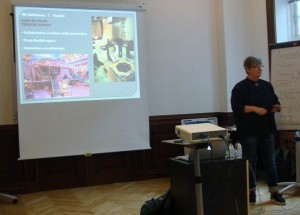Imagine a suite of spaces, specifically designed for and dedicated to exploring, trying out, developing and sharing innovative teaching ideas. Where you can work with a small group of colleagues for a couple of hours, or run a whole day or even a week long event. Where you could bring a cohort of say 50 students to deliver a session utilising all the spaces, or just use the flat room small lecture space. And these diverse learning spaces have individual qualities, most with walls you can write on, some with tall bench tables or a large group table on wheels, some with soft seating, and some with a mixture of furnishings. You can even take a small group on to the large balcony in fine summer weather if you fancy it and no need for interruptions for going out for food, as there is a well equipped kitchen. You also have free access to printers and a cupboard of materials. Of course there are some “permissions” about using the spaces: responsibility for putting equipment away, and leaving the space tidy. But as a teacher this space is there for you to use, and to mine in any way to develop your practice. A fantasy? Well no! This is the Learning Studio at Copenhagen Business School, where I was recently invited to lead a one day workshop on innovative learning space.
Why a Studio?
“Laboratories are plenty in management schools, and they are usually geared towards research. Studios are rare, because they are associated with arts, design or crafts educations. A studio at a management school is an offer to complement lectures and case study discussion with a problem-based, active learning experience that takes place in facilitated groups. A studio thus redefines the role of teachers. While they are central in lectures and case discussions, they move to a facilitative, process-accompanying role in the studio. The student groups are central in studio work, and students have to take a larger responsibility for their learning”. Copenhagen Business School
Although the UK has patches of excellence and innovation in Learning Space Design, we need to also learn from elsewhere.





April 8, 2013 10:34 am
‘Studio’ sounds like an excellent title and approach for learning space design. This is recognised as a creative method of working so why not for education? Particularly like the idea of a kitchen and other facilities – this is a key aspect that we tend to fail to address in UK universities – practical facilities such as a space to hang coats, sockets to charge laptops, food and drink and printing are all needed.